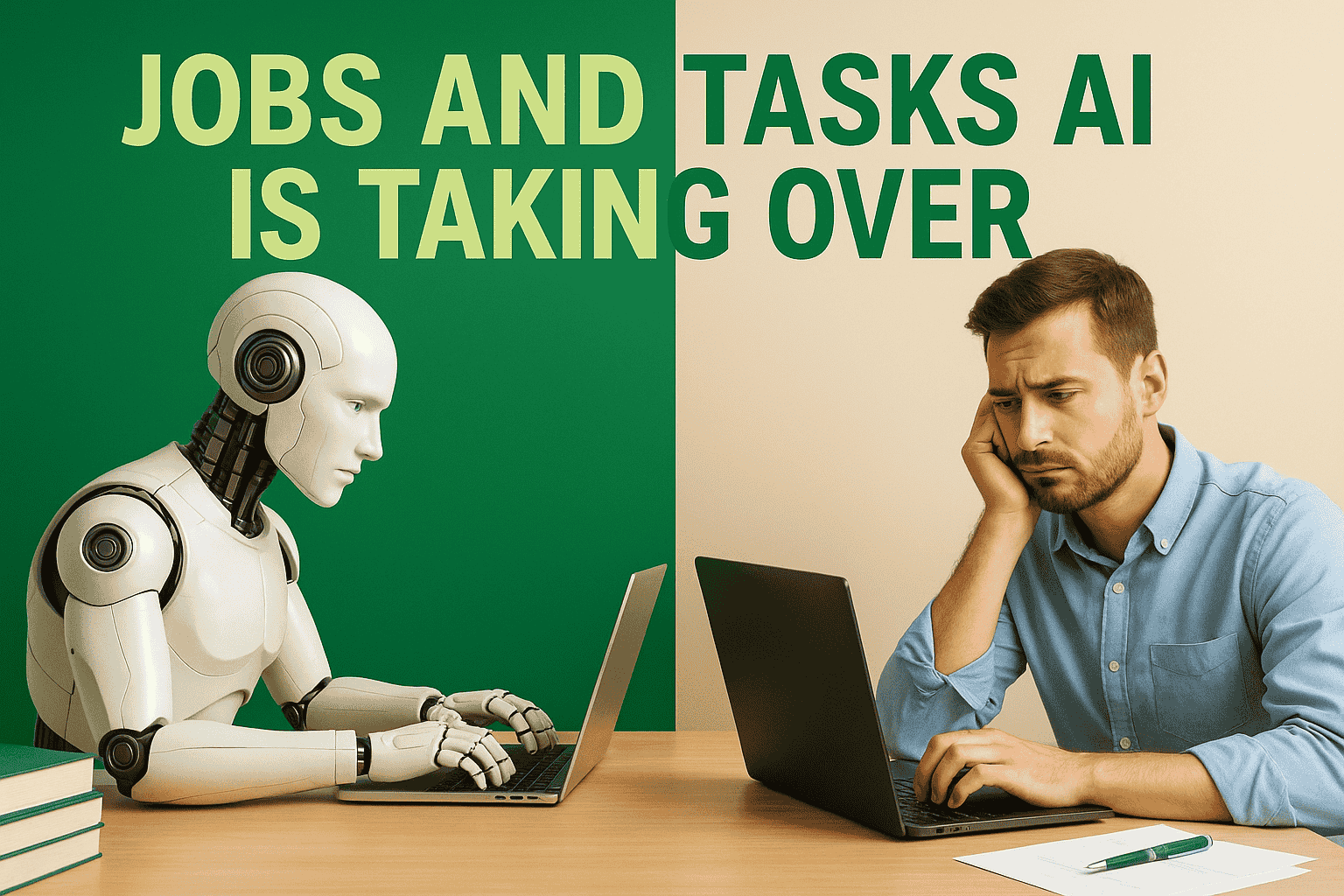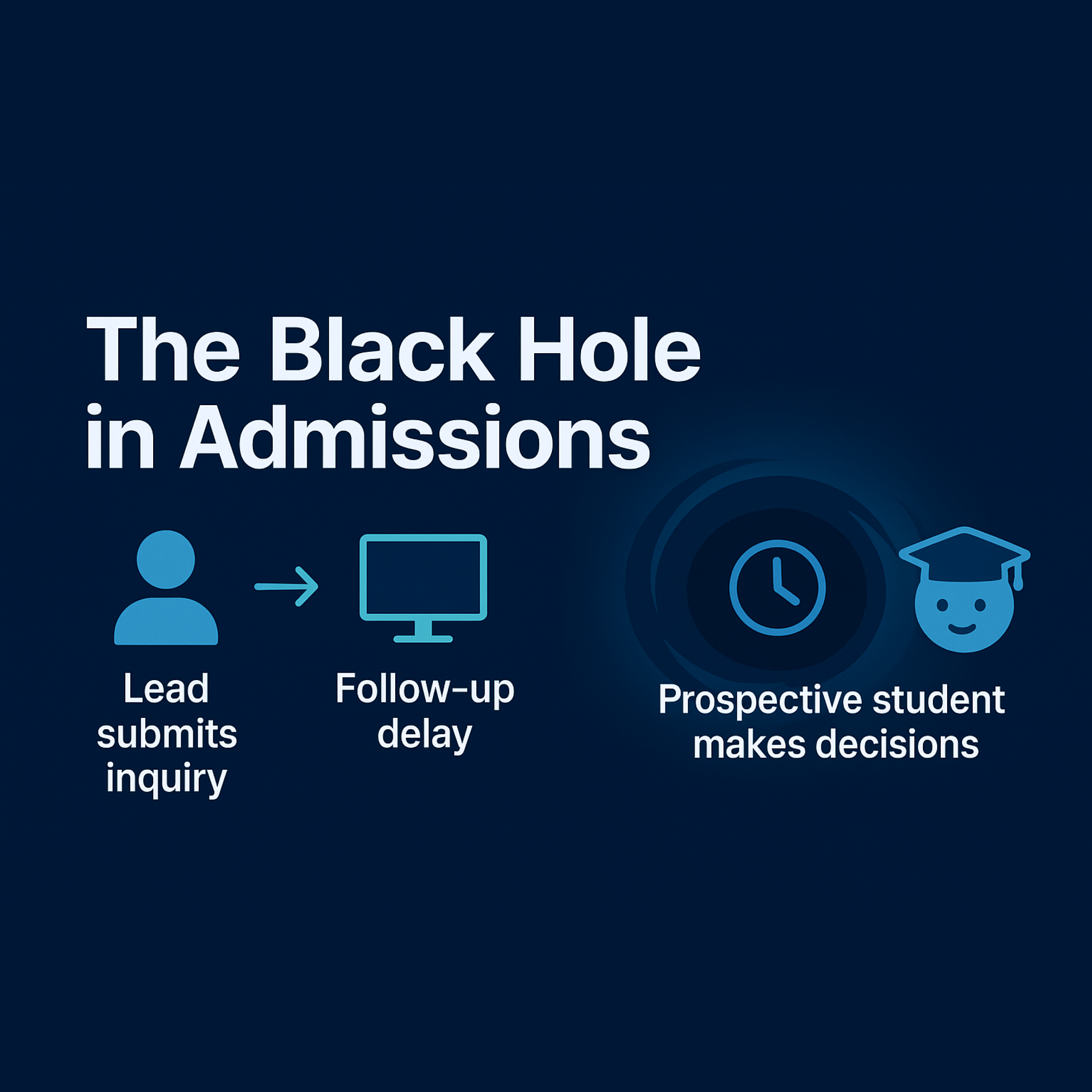Your AI Leadership Roadmap
Colaberry, Inc.
·
16 minute read
AI. It’s not just a buzzword anymore, is it? More like the engine humming beneath the hood of tomorrow’s businesses, promising speed, efficiency, and maybe even a touch of magic.
Introduction: Welcome to the AI Fast Lane!
Jumping in headfirst—seduced by the siren song of algorithms—without a proper roadmap? That’s a recipe for chaos. We’ve all seen the headlines: projects derailed, budgets blown, and teams left scratching their heads, wondering where it all went wrong.
Prefer watching over reading?
Watch our podcast below:
Prefer listening over reading?
listen to our podcast below:
This post is your no-nonsense guide – a field manual, if you will – for navigating the crucial “First 90 Days” of AI adoption in your company. Forget the hype; we’re talking about quick wins, dodging the inevitable landmines, and getting everyone, from the C-suite to the mailroom, not just on board, but genuinely engaged from day one.
Why 90 days? Because it’s the sweet spot. It’s enough time to build momentum, to demonstrate AI’s tangible value beyond the PowerPoint slides, and to lay down a rock-solid foundation of trust and understanding. Think of it as your AI on-ramp – a chance to merge smoothly into the fast lane without causing a pile-up.
A Trip Down Memory Lane: How We Got Here
To understand where we’re going, it’s worth a quick glance in the rearview mirror, isn’t it? AI’s journey hasn’t been a straight line; it’s been more like a winding road with its share of potholes and detours. Here’s a whirlwind tour of the key milestones that brought us to today’s AI boom:
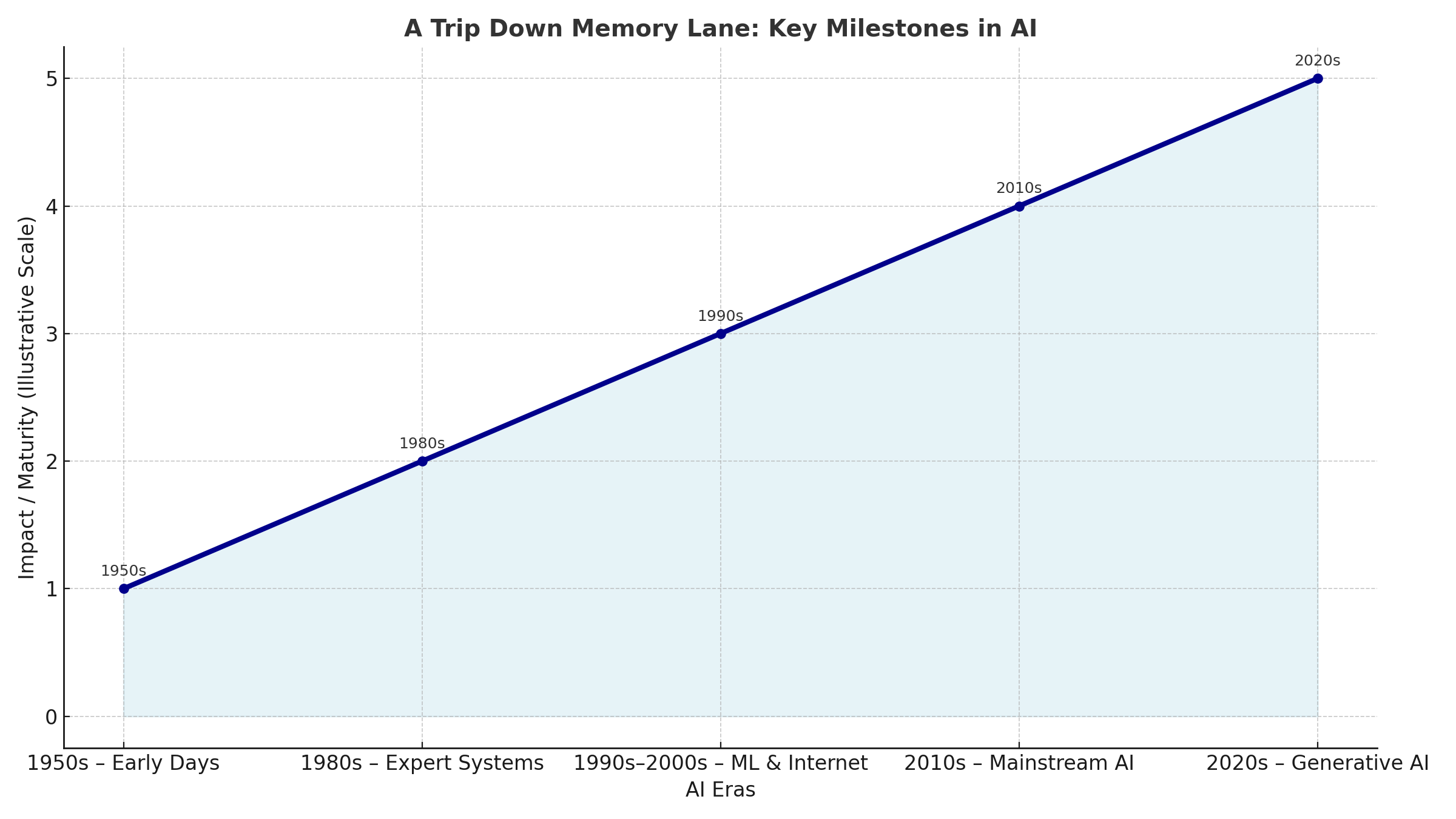
- The Early Days (Think Sci-Fi & Chess Boards): Back in the 1950s, AI was largely the domain of science fiction writers and academics huddled around hulking computers. It began as a fascinating academic dream, deeply rooted in symbolic logic and simple rules. Alan Turing’s groundbreaking tests laid the theoretical groundwork, but practical applications were still a distant gleam in the eye.
- The “Expert System” Era (1980s): The first tentative steps into the business world came with specialized expert systems. Remember Digital Equipment’s XCON? A marvel of its time, it configured complex computer orders and saved the company millions! This was a tantalizing glimpse of AI’s commercial potential. Yet, these systems were costly, clunky, required armies of programmers, and were as rigid as a steel girder.
- Internet Boom & Machine Learning (1990s–Early 2000s): Then came the explosion of the internet, unleashing a torrent of data that fueled AI’s next evolution. Suddenly, AI was recommending books on Amazon (with varying degrees of accuracy, I might add) and IBM’s Deep Blue was beating world chess champions. This was the birth of machine learning – a paradigm shift where systems began to learn from data, not just blindly follow pre-programmed rules. The shift was subtle, yet profound.
- AI Goes Mainstream (2010s): “Hey Siri!” The era of personal assistants dawned. IBM Watson, with its Jeopardy! triumph, demonstrated AI’s ability to tackle complex, nuanced information. AI moved out of specialized labs and into our everyday lives, tackling tasks like speech recognition, image analysis, and spam filtering. The promise of intelligent automation started to feel… well, real.
- The Generative AI Revolution (Now!): And now, the big one. The arrival of GPT-3 and ChatGPT has blown the doors off! AI can create content, design products, even write passable poetry (though I wouldn’t advise replacing Shakespeare just yet). It’s no longer a niche technology; it’s a business imperative, forcing every company to re-evaluate its processes and strategies overnight.
- Early Hiccups & Lessons Learned: It hasn’t all been smooth sailing, of course. Those initial adoption struggles – the exorbitant costs, the limitations of the technology, the yawning talent gap, and the ever-present fear of AI stealing jobs – taught us invaluable lessons. We learned that AI isn’t a magic bullet, that data is king (and queen!), and that ethical considerations can’t be an afterthought. These early stumbles shape today’s (hopefully) smarter strategies.
The AI Landscape Today: What’s Hot, What’s Not
So, where do things stand today? What’s capturing the attention (and budgets) of businesses around the globe in 2025? In short: AI isn’t just growing incrementally; it’s exploding exponentially. Experts aren’t calling it a mere “tech upgrade” – they see it as a fundamental business transformation, a reshaping of how we work, create, and interact. The numbers speak for themselves: nearly all business leaders are optimistic about AI’s impact (in one survey, 92% said AI will improve their business). That’s not just a trend; it’s a tectonic shift in mindset.
Current Trends & What Companies Are Doing:
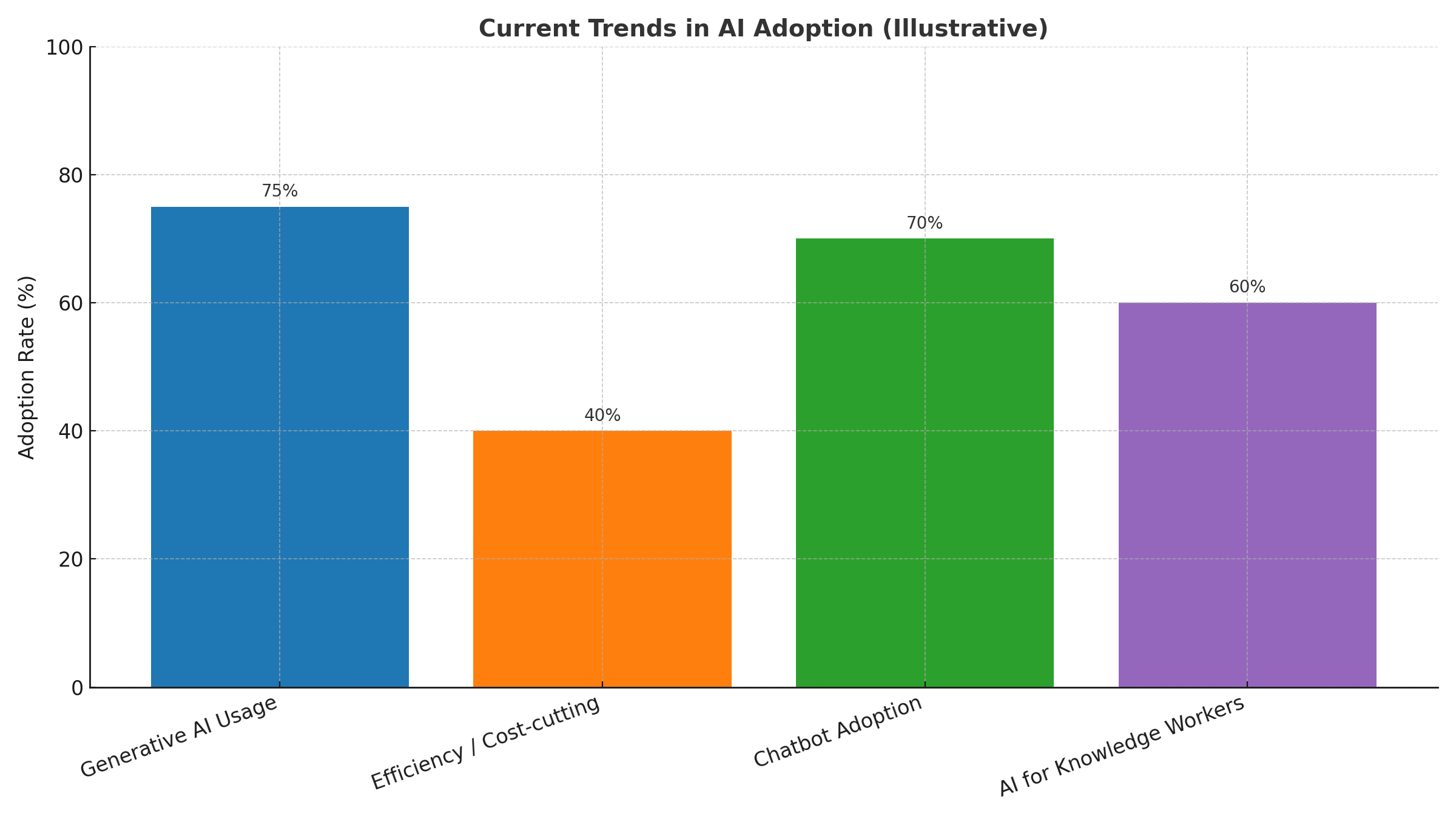
- Generative AI is King: No surprise here – everyone’s scrambling to harness the power of generative AI. Usage has skyrocketed, soaring from 55% to a staggering 75% in just one year, delivering an impressive 3.7× ROI on average for those who deploy it strategically. The allure of AI that can create – whether it’s marketing copy, product designs, or even code – is simply too powerful to ignore.
- Efficiency First: In a world of tightening budgets and pressure to do more with less, nearly 40% of companies are using AI to cut costs and streamline operations. This isn’t about sci-fi dreams; it’s about practical applications that deliver tangible results to the bottom line. Automating routine tasks, optimizing supply chains, slashing processing times – AI is becoming the go-to tool for operational efficiency.
- Chatbots Everywhere: From fielding customer service inquiries to answering internal HR questions, chatbots and virtual assistants have become ubiquitous. These practical, immediate-value tools are now integrated into about 70% of medium-to-large organizations, freeing up human employees to focus on more complex tasks. The result? Faster response times and 24/7 support, without burning out your teams.
- AI for the “Thinkers”: AI is increasingly a daily assistant in white-collar roles across tech, finance, legal, and marketing. Think AI summarizing legal documents, generating financial reports, or personalizing marketing campaigns on the fly. The rise of the “AI-augmented” knowledge worker is well underway – mundane data-crunching out, creative strategy and human judgment in. The highest performers in your office might soon be those who work with AI, not against it.
The Golden Rules (Best Practices Experts Swear By):
- Know Your “Why”: Don’t adopt AI for innovation’s sake, or just because your competitor is doing it. Clearly define what problems it will solve and how it aligns with your core business goals. Start with the problem, not the technology.
- Data is Gold (No, Seriously): We can’t stress this enough. High-quality, clean, well-organized data is the absolute backbone of effective AI. Without it, your AI initiatives are doomed. Get your data house in order before you start experimenting – garbage in, garbage out.
- Start Small, Dream Big: Resist the urge to boil the ocean. Begin with pilot projects and quick wins to demonstrate tangible value, build internal confidence, and refine your approach. Then, scale up strategically, one step at a time. Proof of concept, then proof of value, then scale.
- People Power: Invest in training, foster AI literacy across all levels of your organization, and secure visible buy-in from top leadership. AI isn’t just about technology; it’s about empowering your people to use it effectively. The best AI strategy fails if your people aren’t on board.
- Ethical Compass: Think about bias, privacy, and fairness from day one. Responsible AI isn’t just good PR; it’s good business. Ignoring these ethical considerations can lead to reputational damage, legal trouble, and ultimately a loss of trust. Build ethics into your AI strategy as a non-negotiable.
Bumps in the Road: AI’s Dark Side (and How to Avoid It)
Let’s be honest, the path to AI enlightenment isn’t always paved with good intentions and flawless algorithms. There’s a dark side to AI – potential pitfalls that can trip you up if you’re not careful. Here are some of the most common challenges and how to navigate around them:
- The Job Stealer Myth vs. Job Shifter Reality: The biggest fear, and often the loudest, is AI replacing human jobs wholesale. While AI will undoubtedly automate certain tasks, the reality is more nuanced. It’s more about shifting jobs than outright cutting them – creating new roles that require different skills. Without clear communication, proactive upskilling, and a genuine commitment to supporting employees through this transition, this anxiety can lead to major internal resistance (or even subtle sabotage of AI initiatives).
- The Biased Bot: AI systems learn from data. If your data reflects existing societal biases – gender, race, age, etc. – your AI will perpetuate (and sometimes amplify) them. Remember Amazon’s experimental résumé-screening AI that started favoring male candidates? A stark reminder that biased data leads to biased outcomes. The fix is diligent oversight: diversify your training data, test for biases regularly, and have humans in the loop to ensure fairness.
- The Black Box Problem: If nobody understands how an AI makes its decisions, trust evaporates. Highly complex models can turn into mysterious black boxes. Transparency and explainability are crucial, especially in sensitive areas like finance or healthcare. Imagine an AI denying a loan application without providing a clear rationale – that’s a recipe for customer resentment and regulatory scrutiny. Strive for AI systems that can explain their reasoning in plain language.
- Privacy Nightmares: AI thrives on data, but unchecked data collection can lead to breaches, legal repercussions, and a massive loss of trust. In fact, 45% of organizations that implemented AI have already experienced unintended data exposure, highlighting the urgent need for robust security and privacy protocols. From day one, ensure strict data governance: anonymize where you can, encrypt what you must, and always adhere to regulations (think GDPR and beyond).
- Unclear Goals & Wasted Money: Rushing into AI without a specific, measurable strategy is a surefire way to burn through your budget and end up with nothing to show for it. By some estimates, more than 80% of AI projects fail, often due to a lack of clear objectives and a poorly defined roadmap. Don’t be that statistic! Define success metrics upfront (e.g. “reduce customer churn by 10% in six months using an AI model”) and keep projects aligned with business outcomes.
- The Training Gap: Throwing new AI tools at employees without comprehensive training is like handing them a complex piece of machinery without an instruction manual. It leads to frustration, decreased productivity, and outright rejection of the tools. Avoid this by investing in user-friendly training sessions and ongoing support. When people understand how to use AI and why it’s beneficial for them, they’ll embrace it rather than resist it.
- Siloed Struggles: AI projects need cross-functional collaboration. If every department is off doing its own AI thing in isolation, you’ll end up with incompatible systems, duplicated efforts, and a lot of wheel-spinning. Break down the silos – involve IT, operations, domain experts, and end-users together in AI initiatives. AI thrives on integration, not isolation.
- “Ethical Washing”: Adopting ethical AI frameworks purely for marketing purposes, without a genuine operational commitment, is a dangerous game. Stakeholders and savvy employees can smell insincerity a mile away. Paying lip service to ethics and then behaving badly can backfire spectacularly – eroding trust more deeply than if you hadn’t addressed ethics at all. Authenticity is paramount: mean what you say about responsible AI, and back it up with real action (e.g. ethics committees, bias audits, transparent policies).
Your 90-Day AI Launchpad: A Playbook for Success
Alright, enough with the theory. Let’s get practical. Here’s your 90-day playbook for launching AI successfully in your organization, broken into three phases:
Phase 1: Days 1–30 – Set the Stage, Map the Mission
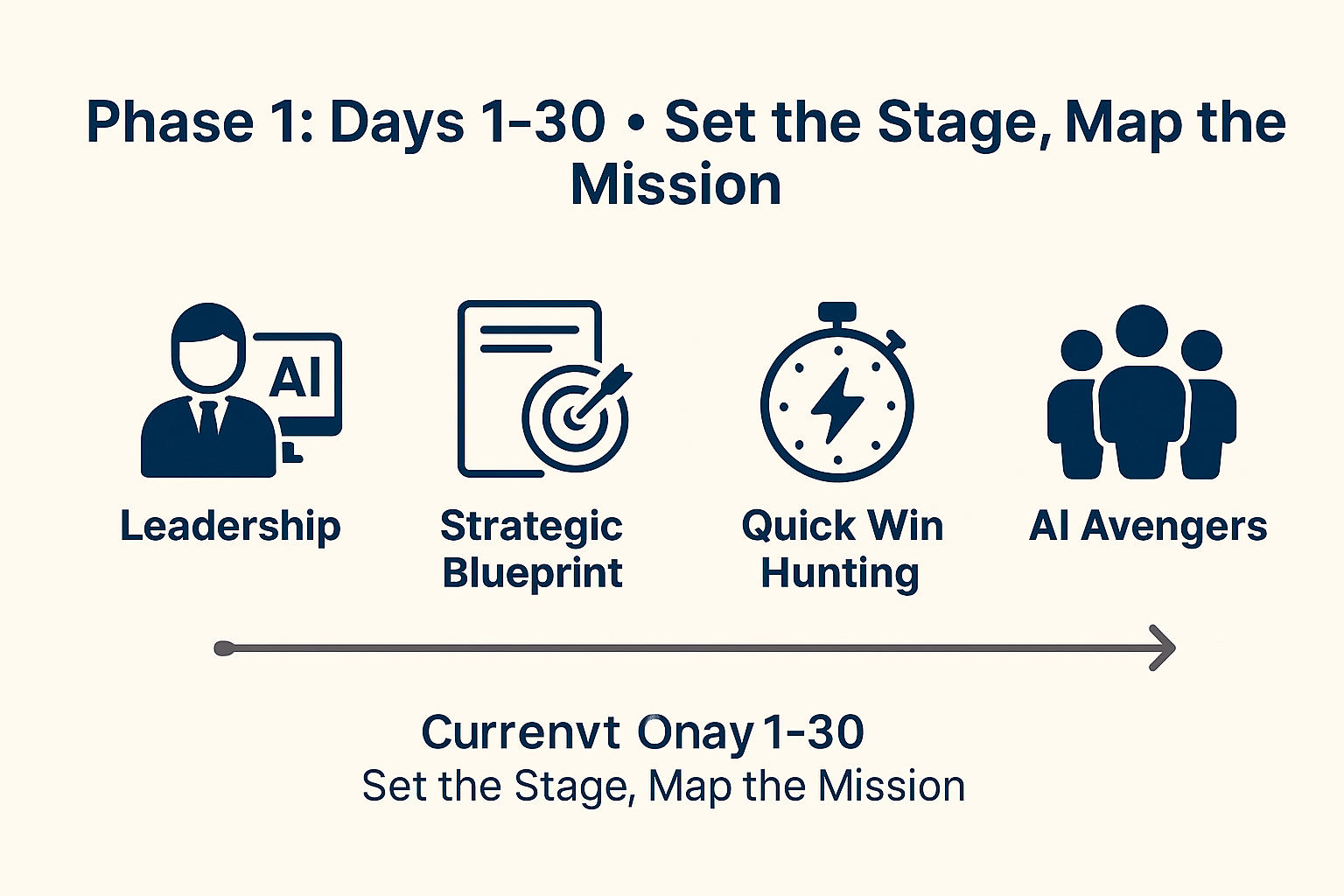
- Leadership, Lights, Action! Senior leaders (yes, even the CEO!) must understand AI fundamentals and visibly champion its adoption from the start. Have them experiment with AI tools themselves and share their learnings with the rest of the organization. Their hands-on enthusiasm sets the tone and creates a culture of experimentation from day one.
- Strategic Blueprint: Clearly define why AI is being introduced and link each initiative explicitly to core corporate goals (e.g. improving customer service ratings, increasing sales forecasting accuracy). Avoid “technology for technology’s sake.” Every AI project should have a clear, measurable business outcome tied to it. Establish this blueprint early, so everyone knows what success looks like.
- “Quick Win” Hunting: Identify low-risk, high-reward tasks to automate – the kind of things that free up employee time and have fairly straightforward implementation. Think automating report generation, summarizing meetings, or drafting standard emails. These quick wins build early confidence and demonstrate immediate value, proving that AI isn’t just hype. Nothing breeds support like a project that saves an employee hours of drudgery each week.
- Form Your Avengers: Create a cross-functional AI task force with representation from IT/data science, the business (the end users of AI), and a senior executive sponsor to break any logjams. Empower this “AI Avengers” team with the resources and authority to experiment, make decisions, and drive the AI agenda. When the right mix of talent rallies together, silos break down and innovation sparks.
Phase 2: Days 31–60 – Build, Test, Tweak!
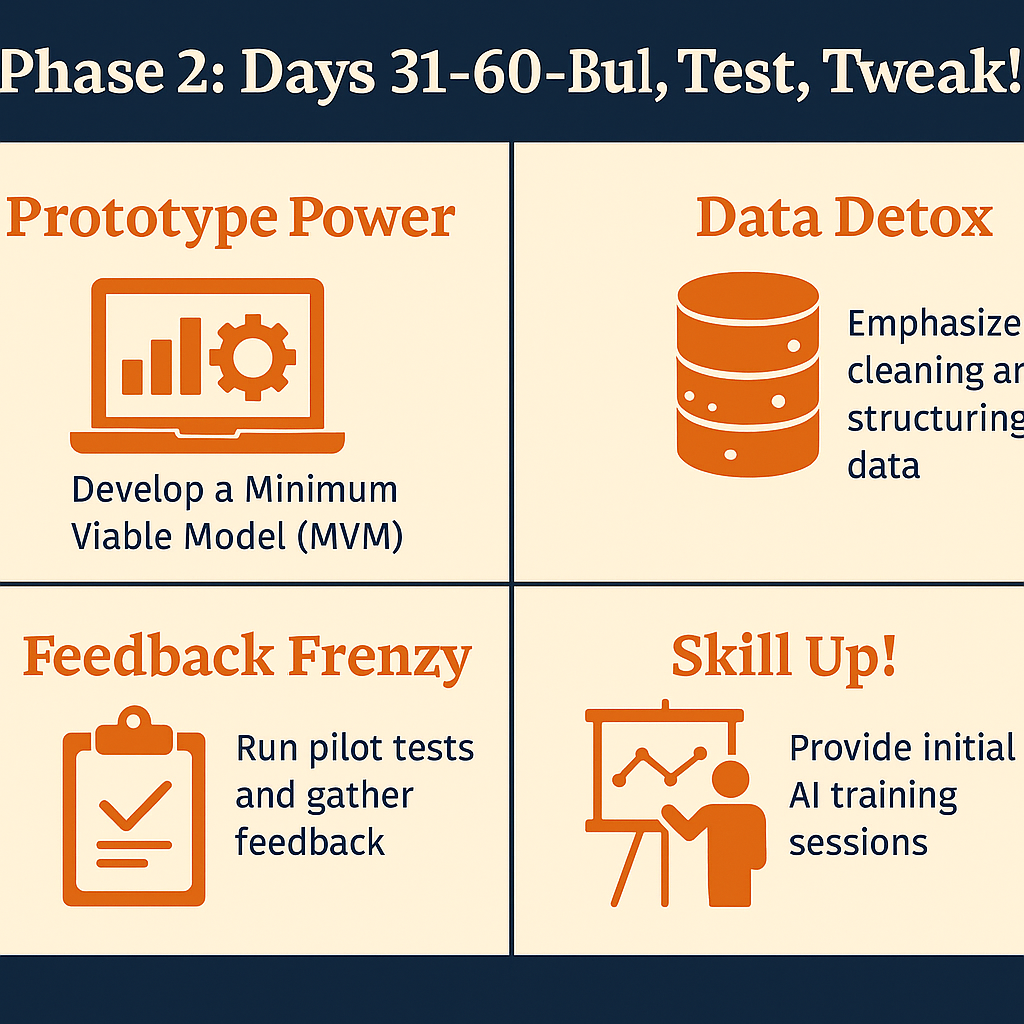
- Prototype Power: Develop a Minimum Viable Model (MVM) focusing on core functionality for your chosen use case. Use pre-trained models or APIs where possible to accelerate development and reduce costs. Don’t try to build the perfect, polished solution from the outset; instead, create a working prototype that stakeholders can see, touch, and give feedback on. It’s all about proving the concept under real-world conditions.
- Data Detox: Emphasize cleaning, structuring, and labeling the datasets relevant to your pilot. Data quality is foundational – remember, garbage in, garbage out. Take the time now to fix data errors, eliminate biases, and ensure you’re feeding your AI good information. Additionally, address data privacy concerns early by anonymizing or shielding any sensitive data used in AI experiments. This will save headaches (and potential compliance issues) later.
- Feedback Frenzy: Run pilot tests in a controlled environment. Have actual end-users try the AI system in their day-to-day workflow and gather their feedback eagerly. Track performance metrics (accuracy, speed, error rates) and user experience anecdotes. Don’t be discouraged by imperfections – every piece of feedback is an opportunity to refine the solution. Iterate quickly (we’re still in the first 60 days, remember!) and show that you’re responsive to input.
- Skill Up!: Provide initial training sessions on the AI tools and applications being introduced. Cover both the technical “how-tos” and the bigger-picture “whys” (i.e. how this will make their jobs easier or more interesting). This is also a good time to discuss ethical considerations specific to the tool (e.g. “Here’s how our AI makes decisions, and here’s how we prevent bias…”). When employees feel confident and informed, they’re far more likely to embrace the new technology.
Phase 3: Days 61–90 – Go Live, Go Smart!
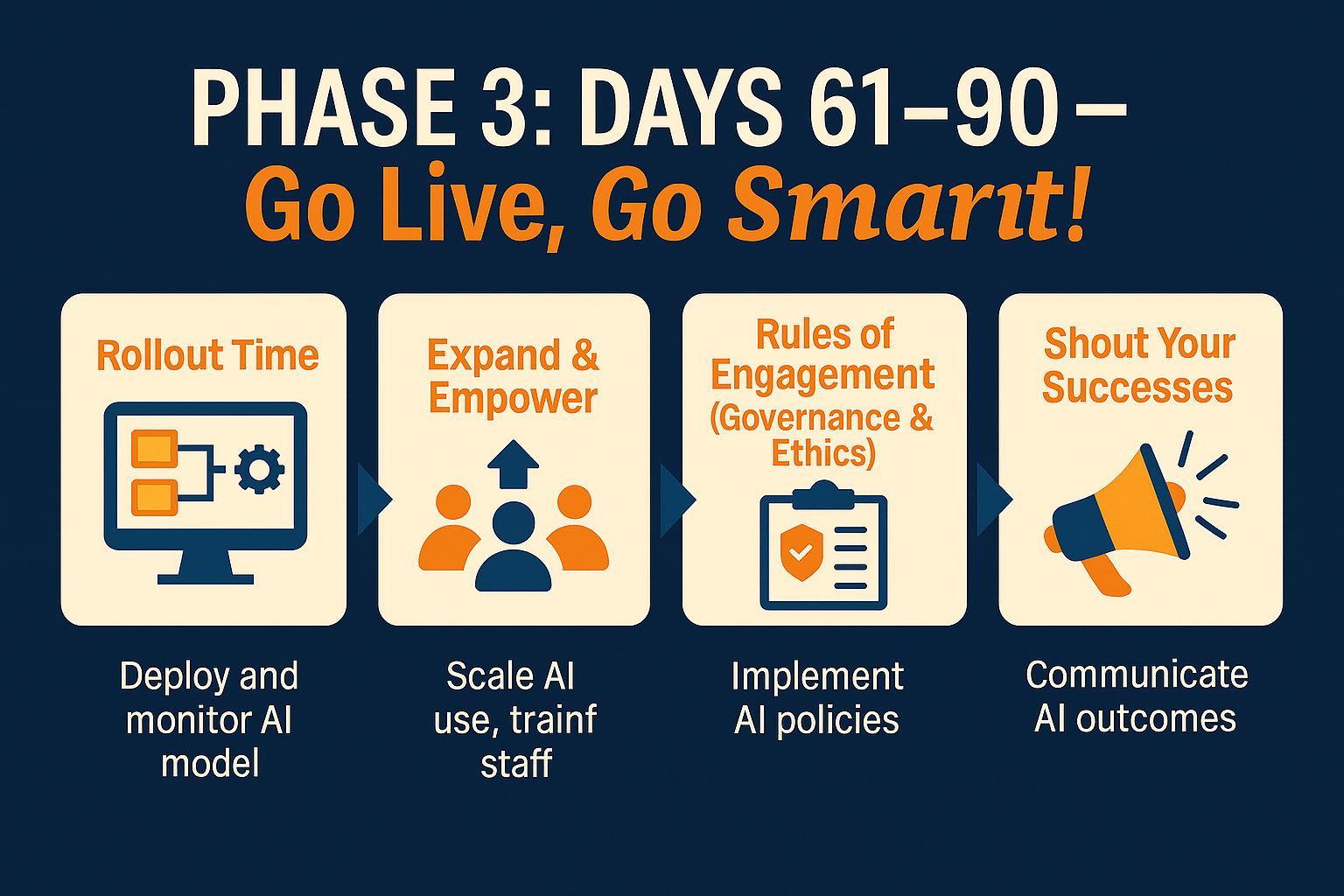
- Rollout Time: If the prototype has proven successful, transition it into operational use. This means integrating the AI model with existing business systems (CRM, ERP, customer support platforms – wherever it needs to live) and setting up proper monitoring for performance and maintenance. Essentially, you’re making the AI part of the furniture. Ensure there’s a support plan in place – who will tune the model if accuracy drifts? Who will reboot things if a service fails at 3 AM? Have those bases covered.
- Expand & Empower: Gradually expand the use of the AI tool to other teams or departments, based on positive pilot results. Maybe your sales team’s chatbot assistant can also help customer support reps, or that fraud detection model in one business unit can be shared with another. Meanwhile, continue cross-training staff to increase AI literacy across the organization. Encourage those who were part of the pilot to become AI champions and mentor their colleagues in other areas.
- Rules of Engagement (Governance & Ethics): By now, you should formalize clear policies and procedures for AI usage in your company. This means guidelines on data privacy, steps to prevent bias, and what to do if the AI outputs something questionable. Set up an AI governance committee or at least a point person responsible for continuous auditing of AI decisions and outcomes. This ongoing oversight will catch issues early and keep your AI deployments on the straight and narrow.
- Shout Your Successes: Continuously track your predefined KPIs and loudly communicate the tangible benefits achieved (e.g. “Our new AI scheduling assistant saved 500 man-hours in the last quarter!” or “Customer satisfaction went up 8% since we introduced our AI chatbot”). Share these wins with all stakeholders and celebrate them—publicly if possible. This not only builds momentum and buy-in internally, but it also reinforces the value of AI to any remaining skeptics on your team.
Core to All 90 Days: Building Trust Internally! Throughout every phase, remember that you’re not just implementing technology – you’re managing a cultural change. A few guiding principles:
- Talk it Out: Be transparent about AI’s purpose, benefits, and how jobs will evolve (not disappear). Address concerns openly and honestly. People are much more likely to trust and support AI when they understand the why and how.
- Train, Train, Train: Offer hands-on practice and clear explanations behind the AI tools. Demystify the technology. When employees see how an AI model works and how it can make their day easier, the fear factor drops dramatically.
- Collaborate, Don’t Dictate: Position AI as an assistant that augments human capabilities, freeing employees for higher-value work, rather than a threat to their jobs. Emphasize the collaborative nature of human-AI partnerships at every turn – it’s our tool, not the IT department’s new mandate.
- Lead by Example: When leaders and managers visibly use and advocate for AI tools in their own work, it normalizes experimentation and signals that AI is a strategic priority, not a flavor-of-the-month fad. Leadership’s actions set the tone; if they’re not walking the walk, why should anyone else?
By the end of these 90 days, you should have not only some AI-driven results to show off, but also a workforce that’s curious, engaged, and maybe even excited about the possibilities of AI.
What’s Next? The AI Horizon
The AI revolution is just getting started. What can we expect to see in the years to come? Buckle up, because the road ahead is moving even faster:
AI Everywhere (Like, Really Everywhere): By 2025, AI isn’t just a tool – it’s poised to be central to nearly every company’s strategy. Business leaders overwhelmingly agree that AI will be at the heart of how we operate. And it’s not just talk: AI’s widespread adoption is expected to boost global GDP in a big way by 2035 (one study projects as much as a 15% increase in global economic output thanks to AI)
pwc.com. In other words, AI will be woven into the fabric of organizations, transforming every aspect of operations from HR to R&D. The question on every CEO’s mind is shifting from “Should we use AI?” to “How do we use AI everywhere we can (responsibly)?”
Mind-Blowing Tech on the Rise:
- Agentic AI: These are AI systems that don’t just assist humans, but can autonomously make decisions and take actions, learning as they go. Think self-managing processes or AI “agents” that handle tasks start-to-finish. Gartner predicts that by 2028, 33% of enterprise software applications will include agentic AI a staggering leap from less than 1% in 2024. The rise of the autonomous AI agent (able to execute workflows with minimal human intervention) could revolutionize how work gets done. Imagine an AI that can not only draft your report but also decide when it’s good enough to send, and then actually send it.
- Multimodal AI: AI that understands everything at once – text, images, video, audio – leading to much richer interactions and insights. We’re talking AI customer service that can watch a customer’s live video and read their chat at the same time, or an AI that designs a product by both drawing it and describing it. This convergence of modalities means more human-like understanding and more creative applications. The barriers between “visual AI” and “language AI” are falling, and it’s opening up a world of new possibilities.
- AI That Reasons: Moving beyond simple pattern recognition to logical problem-solving, mimicking aspects of human thought processes. This is the holy grail of AI research: systems that can chain together thoughts or steps to reason through a complex problem or explain why they made a decision. Early signs of this are emerging in advanced chatbots that can follow multi-step instructions or perform basic reasoning tasks. In the future, we might trust AI not just to give answers, but to solve open-ended problems in real time.
- Explainable AI (XAI): As AI decisions permeate more of our lives, the demand for transparency is rising. Expect a big emphasis on AI that can clearly explain how it arrived at a decision or recommendation. This is crucial for building and maintaining trust, especially in regulated industries. We’ll see better tools and standards for AI explainability – think AI “auditing” systems that can show you the decision path the algorithm took. In short, the black box is slowly opening up.
Smarter Strategies for a Smarter Future:
- “AI-First” Mentality: Much like “mobile-first” design swept through tech a decade ago, companies will begin to adopt an “AI-first” approach. This means whenever a new process, product, or strategy is discussed, the question will be: How can AI enable or enhance this? Companies that build continuous AI improvement into their DNA – constantly updating models, experimenting with new AI capabilities, and staying agile – will outpace those that treat AI as a one-off project. In the next few years, agility and adaptability with AI will be key competitive differentiators.
- Data Mastery (Even More So!): If you think data was important before, future AI makes it even more critical. We’ll see even greater focus on robust, clean, and secure data architectures. Technologies for real-time data integration, data lakes, and data governance will boom. Companies will invest heavily in mastering their data pipelines, because without a steady supply of high-octane fuel (quality data), even the fanciest AI engine will sputter.
- Human-AI Harmony: The future workforce will be a symbiosis of humans and AI. We’ll see roles broaden and blend, requiring a new set of skills and competencies. Humans will focus more on strategy, creativity, oversight, and complex problem-solving, while AI handles execution, number-crunching, and routine decision-making. Job descriptions will evolve: “AI supervisors,” “human-AI team managers,” and “AI ethicists” could become common titles. The companies that thrive will be those that redefine workflows to maximize this partnership – letting each do what it does best.
- AI Democratization: AI is becoming cheaper, more efficient, and more accessible to businesses of all sizes. Thanks to declining costs and the rise of no-code or low-code AI platforms, the barriers to entry are falling rapidly. A small startup today can leverage cloud-based AI services that were once the domain of tech giants. This democratization means innovation can come from anywhere – a two-person garage company can potentially build an AI-driven product as powerfully as a Fortune 500 company. The playing field is leveling (at least somewhat), which is exciting and a bit scary for established players.
- Government Stepping In: As AI’s impact on society grows, expect increased government investment and clearer regulations to shape AI’s ethical development and deployment. We’re already seeing nations publish AI strategy papers, propose AI-specific laws, and fund AI research at unprecedented levels. Governments will play a crucial role in ensuring AI benefits society as a whole – setting guardrails on issues like data privacy, algorithmic bias, and AI safety. Smart businesses will stay ahead of these regulations by building ethical practices now, rather than scrambling to comply later.
The Bottom Line: Embrace the Change!
The AI revolution is here. It’s not a question of if AI will transform your business, but how. The first 90 days are your make-or-break moment for successful AI adoption. Get leadership on board, find those quick wins, prioritize internal trust and ethical practices, and plan for continuous evolution. Don’t just watch the AI revolution happen; be a part of it. Start your 90-day AI journey today and transform your business for tomorrow. The future is intelligent. Are you ready?
Partnering with Colaberry: Your AI Co-Pilot for Success
Feeling excited about what AI can do, but unsure how to execute it flawlessly in those first 90 days (and beyond)? You’re not alone. The journey can be complex – but you don’t have to go it alone. Sometimes the smartest move is having a seasoned co-pilot in the passenger seat. That’s where a partnership with Colaberry comes in. Colaberry, an industry leader in AI and data science consulting, has helped numerous organizations kickstart their AI initiatives and navigate the twists and turns of transformation. We bring a wealth of experience (over a decade in the game) to make sure you don’t trip at the starting line. Here’s what you get with Colaberry by your side:
- Expert Strategic Alignment: We start by working with your leadership to clarify your AI vision and link initiatives to your core business goals. Colaberry’s experts ensure every AI project answers a real business need and has clear success metrics from the outset. No vague science experiments – we define the “north star” outcomes so your AI efforts stay on course and deliver ROI (not just cool demos).
- Quick Wins & Prototype Acceleration: Using our experience across many successful AI projects, we help identify high-impact quick wins suitable for automation in your context. Our team can rapidly build prototype solutions (leveraging pre-trained models and proven frameworks) to demonstrate tangible value in weeks, not months. By focusing on achievable wins first, we build momentum and confidence in your organization. You’ll see time saved, costs cut, or revenues boosted early in the journey – critical proof points for stakeholders.
- Data Readiness & Security by Design: Colaberry’s data engineers and AI specialists will audit and prepare your data from day one. We’ll help you clean and structure your data, and set up robust governance and privacy practices upfront. Why is this important? Consider that nearly half of organizations have hit data exposure snags when rolling out AI. With Colaberry, you get battle-tested data pipelines and security protocols, so your AI runs on clean, reliable data without putting sensitive information at risk. It’s like giving your AI the high-octane fuel it needs – safely.
- Upskilling & Team Empowerment: A partnership with Colaberry isn’t just about deploying tech – it’s about empowering your people. Through Colaberry’s training programs and on-site workshops, we help elevate your team’s AI literacy at all levels. From hands-on sessions for your analysts and engineers, to executive briefings for your leaders, we demystify AI and build confidence. We’ll work alongside your employees (“teach them to fish”) so that fear of AI turns into excitement about what they can do with AI. (And by plugging into Colaberry’s diverse talent network, you also gain immediate access to data scientists and engineers skilled in the latest AI and ChatGPT-tech – filling any talent gaps instantly.
- Seamless Integration & Ongoing Support: Colaberry guides the integration of AI solutions into your existing workflows and IT systems, ensuring a smooth go-live when the time comes. We don’t just hand you a model and disappear; we monitor performance, help tune the system, and make adjustments post-launch so you continue to get optimal results. As your quick wins turn into broader AI strategies, we’re there to help scale up what works. And importantly, we help you institute the governance, ethical checks, and KPI tracking to keep your AI initiatives on track and delivering value long after the first 90 days.
In short, Colaberry serves as your experienced co-pilot in the AI fast lane – helping you avoid the potholes, navigate the curves, and accelerate toward success. With our partnership, you get the technical muscle, the strategic insight, and the people-centric approach needed to turn that 90-day playbook into reality. We’ll help you embrace the change and manage the change, ensuring that by the time the checkered flag waves, your company isn’t just in the race – it’s leading it.
Embrace the AI revolution with confidence, and let’s cross that finish line together. The future is intelligent – and with Colaberry’s help, your organization will be too. Are you ready to seize the opportunity?

-png.png)
